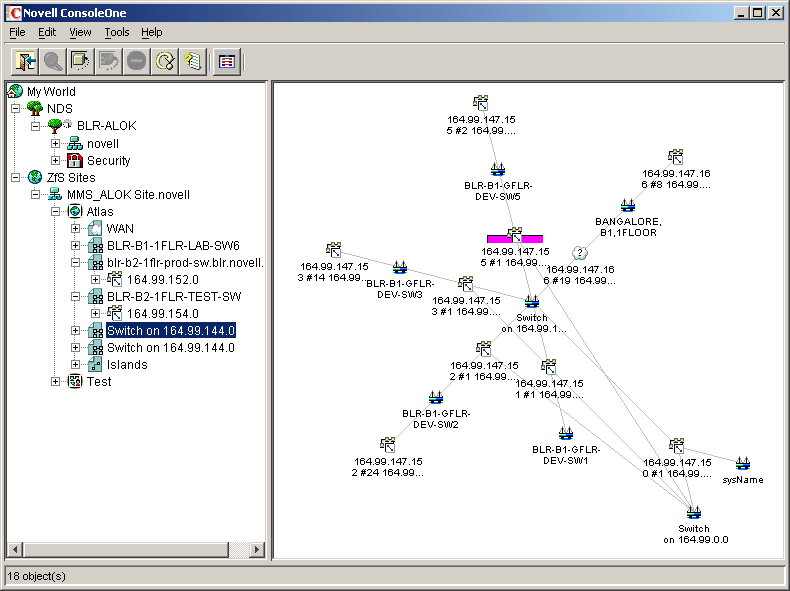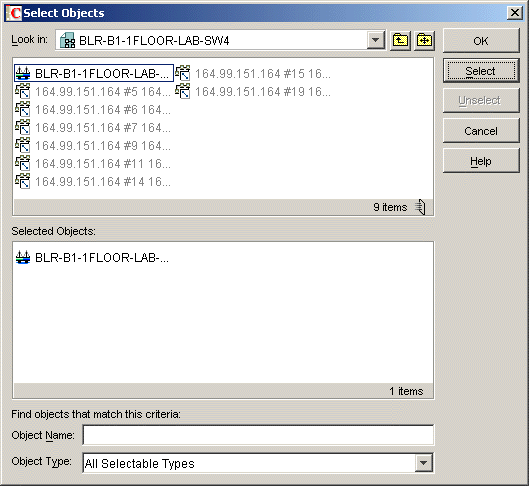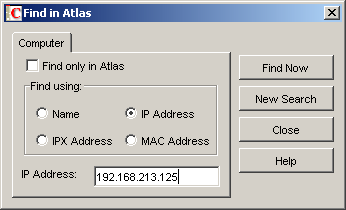23.3 Managing the Atlas
After the initial discovery, you can stop discovery running on the management server. You can, however, continue to access the database through the Atlas Manager. The discovery cycle starts again the next time NetExplorer is up. The Consolidator populates the database and the Atlas Manager automatically updates the atlas pages.
Depending on the size of your network, writing data from the initial discovery cycle can take few minutes to several days. Subsequent discovery updates to the database require substantially less time.
23.3.1 Using the Atlas
When Novell ZENworks Server Management is first installed, the server module of the Atlas Manager is automatically installed on the management server, and the client module of the Atlas Manager is installed on Novell ConsoleOne. The Atlas Manager on the management server creates a system atlas and provides a graphical view of the database at the console.
The Atlas Manager on the server reads the database and provides two different views of the database at Novell ConsoleOne: the Console view and Atlas view. Both views provide information about the discovered network topology, the physical location of nodes, node configuration information, and alarm information.
The following sections gives you an understanding about using the atlas:
Accessing the Atlas
You can access the Novell ZENworks Server Management atlas from Novell ConsoleOne. Open Novell ConsoleOne and double-click the Novell ZENworks Server Management Domains namespace, then expand the domain. The system atlas appears.
Table 23-9 describes a Novell ZENworks Server Management atlas consisting of three different pages:
Table 23-9 Three-page Atlas
Customizing Your Atlas View
You can customize your atlas view in three different ways:
-
Insert a custom bitmap as the background on an atlas page.
-
Change the position of a node on an atlas page by dragging it.
-
Display objects by an alternate name.
Assigning Roles to Help You Manage the Atlas
Novell ZENworks Server Management lets you assign roles to manage the atlas. By assigning roles, you can restrict the user from performing specific operations on that object.
HINT:The atlas displays maps based on your role on the network. For example, if your role is restricted to managing certain servers in segment A and B, your atlas will contain only those servers in segments A and B.
You can perform the following tasks on any atlas page (WAN, Islands, or Area page) when the Atlas view is displayed on Novell ConsoleOne:
Using the Atlas to Troubleshoot
By setting the alarm disposition to save alarms in the database, Novell ZENworks Server Management maps can alert you to alarm conditions on the network. Alarms are of type severe, major, or minor alarm on a segment or node. Upon recognizing any of these alarms, the ConsoleOne displays different colors above the object depending on the severity of the alarm as shown in Table 23-11:
The alarm status is propagated up the hierarchy. For example, if a server has an alarm of type severe, the segment and the page containing the server will display the corresponding alarm icon. For information about alarms, Section 24.2, Managing the Alarm Management System.
Figure 23-16 shows the atlas namespace in ConsoleOne:
Figure 23-16 Atlas namespace in Novell ConsoleOne

Custom Maps
Custom Maps enable you to create and delete custom atlases and custom containers and group nodes into containers. You can also create a hierarchy of objects in atlas. An atlas can contain custom containers. you can create a node or a sub container within the custom container. However nodes cannot be directly contained under the atlas.
You can perform the following operations in the custom atlas:
Creating a Custom Atlas
-
Right-click the site object where you want to create the custom atlas, then click > .
-
Specify the name of the atlas.
-
Click .
Creating a Custom Container
You can create a custom container within a new custom atlas. You can also create a subcontainer within a container.
-
Right-click the custom atlas you created, then click > .
or
In the right-pane of Novell ConsoleOne, right-click the custom container you created, then click > .
-
Specify the name of the container.
-
Click .
Adding Nodes to the Container
You can associate multiple nodes to a container.
-
Right-click the custom container you created, then click .

-
Select the nodes you want to add to the container.
-
Click .
The selected nodes are displayed in the list.
-
Click .
Renaming the Custom Atlas Objects
-
Select the atlas object you want to rename.
-
Click .
-
Specify a new name.
-
Click .
Deleting Custom Atlas Objects
-
Select the atlas object you want to delete.
-
Click .
Locating Nodes in the Custom Atlas
You can locate particular node in the specific atlas or across all the atlases that are present. To locate nodes in the same atlas, select the Find only in atlasname check box. If you do not select this check box, then the node will be located in all the atlases.
Figure 23-17 Find in Atlas Dialog Box

-
Right-click the custom atlas, click .
-
Specify the conditions to base your search on.
-
Click .
The location of the network object in the custom atlas is displayed in a list in the Find In Atlas dialog box.
-
To jump to the location of the node, double-click the node.
-
Click .
Locating All Occurrences of the Nodes
-
Right-click the node whose occurrences you want to locate, then click .
The occurrences of the nodes are displayed in the Locate All Occurrences dialog box.

-
To jump to the location where the node exists, double-click the node.
-
Click .
Copying Nodes to a Custom Container
You can copy nodes to the custom container you have created.
-
Select the nodes you want to copy, then right-click and select .
-
In the Select Objects dialog box, locate the custom container where you want to copy the nodes to.
-
Click .
Node Naming Order
As discovery cycles proceed and more information is discovered, the names displayed in the maps can change. Different priorities are given to names, depending on the source of the name information. If none of the names are discovered, the IP/IPX address of the node is displayed as the node name.
To determine how to display the name of the discovered object, the Atlas Manager uses the following list in the order shown:
-
User - defined name
-
DNS Name
-
Novell eDirectory Name
-
Bindery Name
-
SNMP Name
Use the Node Name Order dialog box to change the order of display.
-
At the atlas level, select > .

-
Use the following options:
-
Move Up: Changes the order of the node names.
-
Move Down: Changes the order of the node names.
-
Save Changes: Saves the changes you made.
-
Ignore Changes: Ignores the changes you made.
-
23.3.2 VLAN Atlas
VLAN Atlas provides a logical view of all VLANs present in the network. VLAN feature uses the custom atlas framework to create a VLAN-specific atlas.

Under VLAN atlas, you can see all the networks running on different VLANs.
The naming convention for the VLANs is VLAN_name. All the machines belonging to a particular VLAN, are placed in respective containers.The assumption made is that, in a given organization the names of VLANs are distinct.
Because VLAN Atlas is a custom atlas, all the operations that are possible in a custom atlas are possible for VLAN Atlas as well. However, renaming or deleting a container is not possible.
Only port-based VLANs are currently supported on Baystack, Extreme, and Cisco switches.
23.3.3 Using Unified Views
The Unified view service is a service that acts as a filter on the atlas. Using the Unified view, you can filter for a list of devices or segments of a particular type. The Unified view allows easy navigation and quick operations to check the highest severity of the alarms present on a particular node or segment.
The following are the two types of Unified view provided:
Unified View for Devices
You can view All, Manageable, or Unmanageable devices in this view. For a corresponding device type, a device is said to be manageable if the list of MIBs implemented by the device satisfies the Manageability_definition property in the unifiedview.ini file in the novell zenworks\mms\mwserver\bin directory. The Manageability_definition property can be updated with a valid boolean expression of MIB names.
Following are the device types that you can filter:
-
All (all types of devices)
-
NetWare Servers
-
NCP Print Servers
-
TCP Services
-
Printers
-
IP Routers
-
Switches/Bridges
-
IPX Routers
-
Windows Servers
To filter the devices:
-
In the atlas, select > .
-
From the first drop-down list, select to list all the devices.
or
Select to list the manageable devices.
or
Select to list the unmanageable devices.
-
From the second drop-down list, select a device type.
-
Click.
The Unified view will display the list of the devices. The tabular column in the Unified view contains the following information:
-
The icons associated with the devices.
-
The MIBs implemented by the device. If the device does not implement any MIBs the column will specify “No MIBs implemented” for that device.
-
The maximum severity of the alarms against the devices. To view the legend for the alarm, select the alarm legend button on the toolbar.
Unified View for Segments
You can view All, Manageable, or Unmanageable segments in this view. For a corresponding segment type, a segment is said to be manageable if the list of MIBs implemented by at least one device in that segment satisfies the Manageability_definition property in the unifiedview.ini file. The Manageability_definition property can be updated with a valid boolean expression of MIB names.
The following are the segment types you can set filter for:
-
All (all types of segments)
-
Ethernet
-
Frame Relay
-
IPX Compatibility Mode
-
Token Ring
-
X.25
-
PPP
-
ATM
-
FDDI
To filter the segments:
-
At the Atlas level, select > .
-
From the first drop-down list, select to list all the segments.
or
Select to list the manageable segments.
or
Select to list the unmanageable segments.
-
From the second drop-down list, select a segment type.
-
Click .
The Unified view will display the list of the segments. The tabular column in the Unified view contains the following information.
-
The icons associated with the segments.
-
The name of the segment.
-
The maximum severity of the alarms against the segments. To view the legend for the alarm, select the alarm legend button on the toolbar.


